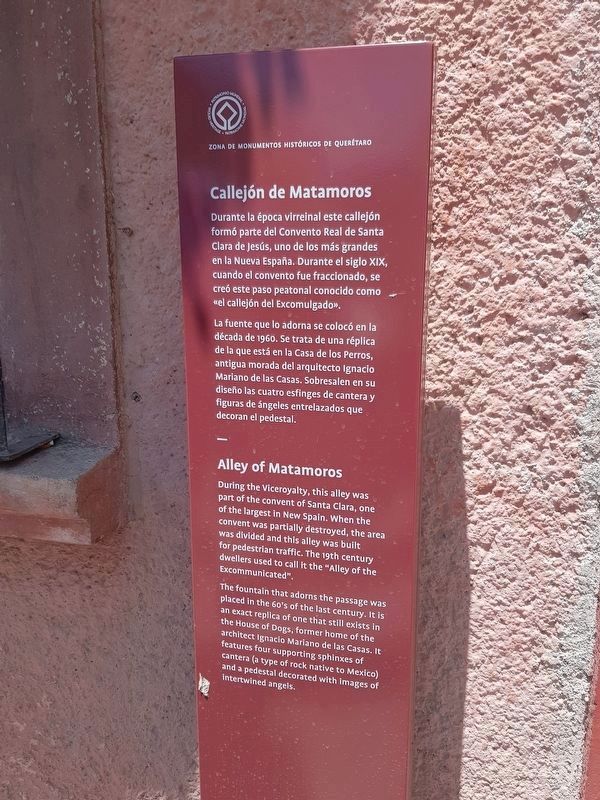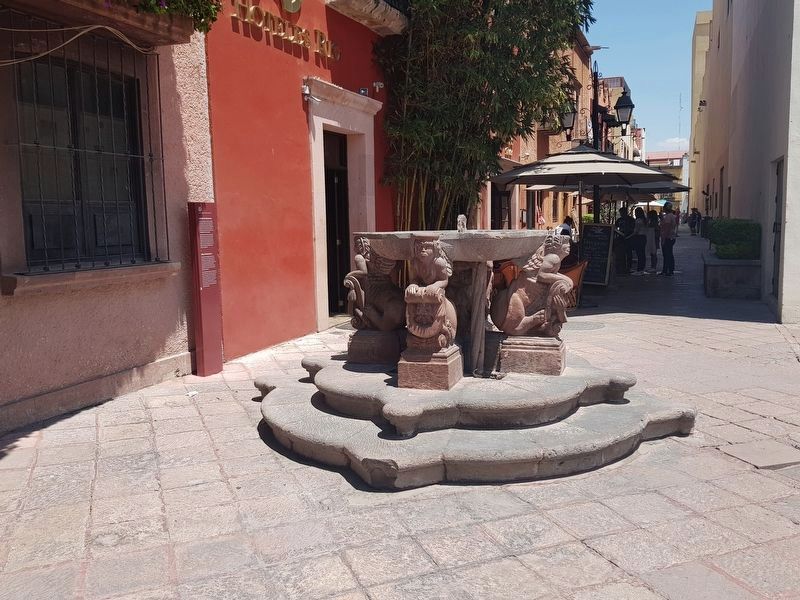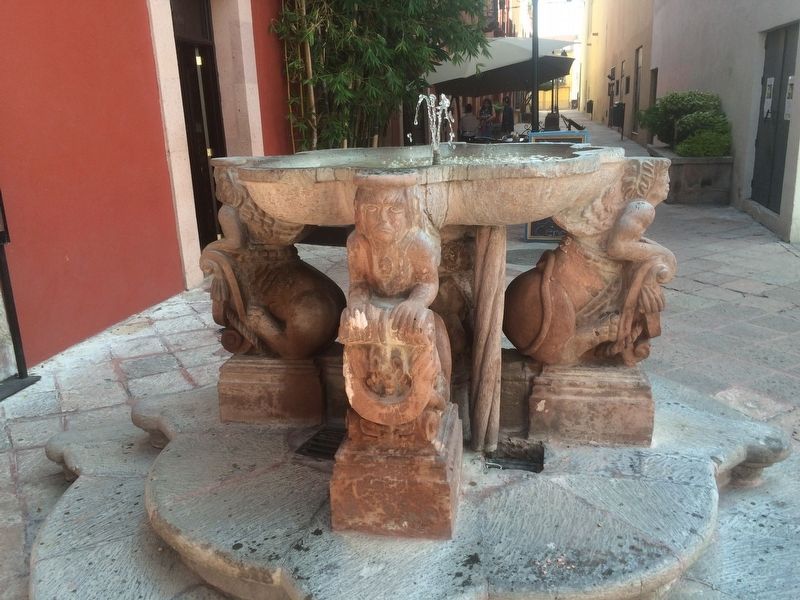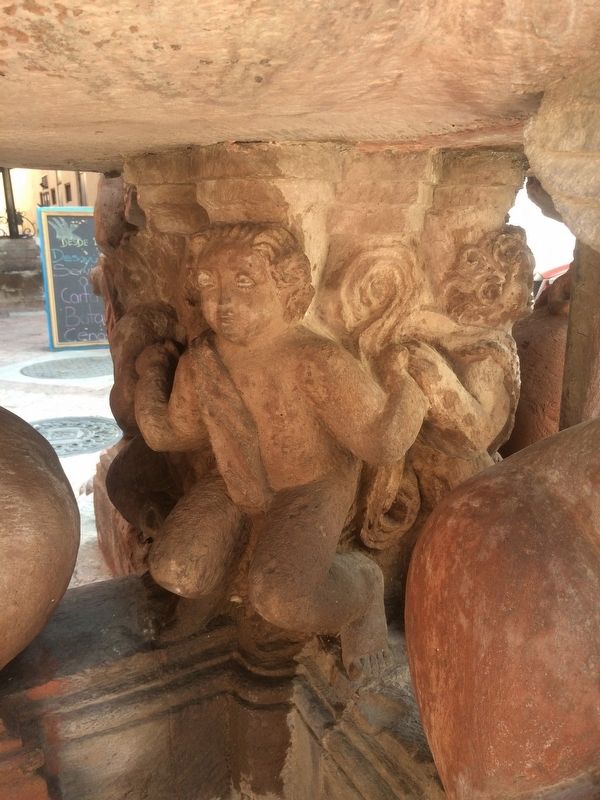Santiago de Querétaro in Querétaro, Mexico — The Central Highlands (North America)
Alley of Matamoros
Inscription.
Callejón de Matamoros
Durante la época virreinal este callejón formó parte del Convento Real de Santa Clara de Jesús, uno de los más grandes en la Nueva España. Durante el siglo XIX, cuando el convento fue fraccionado, se creó este paso peatonal conocido como “el callejón del Excomulgado”.
La fuente que lo adorna se colocó en la década de 1960. Se trata de una réplica de la que está en la Casa de los Perros, antigua morada del arquitecto lgnacio Mariano de las Casas. Sobresalen en su diseño las cuatro esfinges de cantera y figuras de ángeles entrelazados que decoran el pedestal.
Alley of Matamoros
During the Viceroyalty, this alley was part of the convent of Santa Clara, one of the largest in New Spain. When the convent was partially destroyed, the area was divided and this alley was built for pedestrian traffic. The 19th century dwellers used to call it the "Alley of the Excommunicated".
The fountain that adorns the passage was placed in the 60's of the last century. It is an exact replica of one that still exists in the House of Dogs, former home of the architect Ignacio Mariano de las Casas. It features four supporting sphinxes of cantera (a type of rock native to Mexico) and a pedestal decorated with images of intertwined angels.
Erected 2018 by Municipalidad de Querétaro.
Topics. This historical marker is listed in these topic lists: Churches & Religion • Colonial Era. A significant historical year for this entry is 1960.
Location. 20° 35.577′ N, 100° 23.706′ W. Marker is in Santiago de Querétaro, Querétaro. Marker can be reached from the intersection of Andador Matamoros and Guadalupe Victoria. Touch for map. Marker is in this post office area: Santiago de Querétaro QUE 76000, Mexico. Touch for directions.
Other nearby markers. At least 8 other markers are within walking distance of this marker. Last Prison of Maximilian (within shouting distance of this marker); Temple and former Convent of Capuchins (within shouting distance of this marker); Manuel de la Peña y Peña (about 90 meters away, measured in a direct line); Benjamin N. Velasco Military Institute (about 90 meters away); Temple and former Convent of Santa Clara (about 120 meters away); Tribute to Juan Antonio de Urrutia y Arana (about 120 meters away); Vicente Guerrero (about 120 meters away); Vicente Guerrero Garden (about 120 meters away). Touch for a list and map of all markers in Santiago de Querétaro.
Regarding Alley of Matamoros. Conín, mentioned
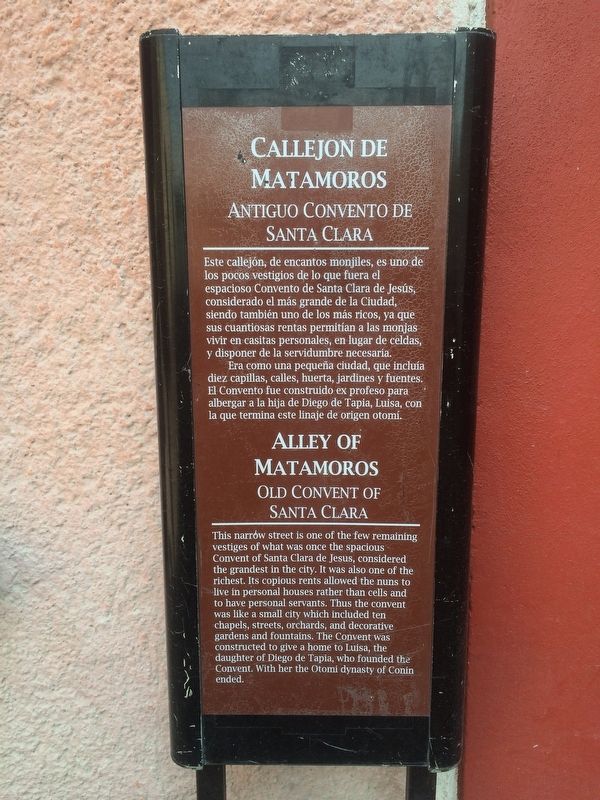
Photographed By J. Makali Bruton, October 2, 2016
2. The previous Alley of Matamoros Marker
This previous marker was replaced in 2018. Its text read:
Callejon de Matamoros
Antiguo Convento de Santa Clara Este callejón, de encantos monjiles, es uno de los pocos vestigios de lo que fuera el espacioso Convento de Santa Clara de Jesús, considerado el más grande de la Ciudad, siendo también uno de los más ricos, ya que sus cuantiosas rentas permitían a las monjas vivir en casitas personales, en lugar de celdas, y disponer de la servidumbre necesaria.
Era como una pequeña ciudad, que incluía diez capillas, calles, huerta, jardines y fuentes. El Convento fue construido ex profeso para albergar a la hija de Diego de Tapia, Luisa, con la que termina este linaje de origen otomi.
Alley of Matamoros
Old Convent of Santa Clara
Antiguo Convento de Santa Clara
Era como una pequeña ciudad, que incluía diez capillas, calles, huerta, jardines y fuentes. El Convento fue construido ex profeso para albergar a la hija de Diego de Tapia, Luisa, con la que termina este linaje de origen otomi.
Old Convent of Santa Clara
Diego de Tapia was the son of Conin. Diego de Tapia's daughter, Luisa, was born in 1590 and died on September 22, 1663. She was a nun, abbess and supporter of the Santa Clara de Jesus Convent, the fourth largest in New Spain. She is also known by her Christian name of María Luisa del Espíritu Santo.
The marker was replaced in 2018 with updated text but in the same location as a marker with the same name. The marker also mentions that the area is part of the Zone of Historical Monuments of Querétaro (Zona de Monumentos Históricos
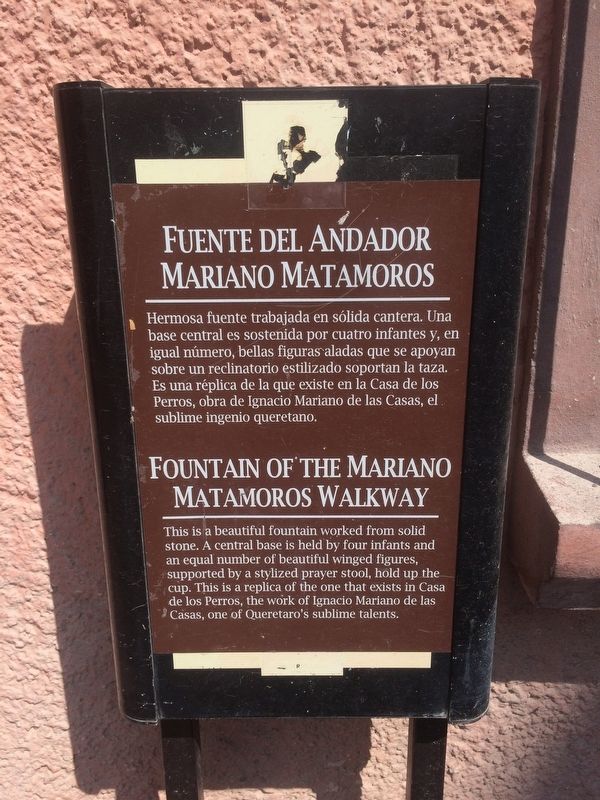
Photographed By J. Makali Bruton, October 2, 2016
3. The previous Fountain of the Mariano Matamoros Walkway Marker
This additional marker was removed in 2018. It read:
Fuente del Andador Mariano Matamoros
Hermosa fuente trabajada en sólida cantera. Una base central es sostenida por cuatro infantes y, igual número, bellas figuras aladas que se apoyan sobre un reclinatorio estilizado soportan la taza. Es una réplica de la que existe en la Casa de los Perros, obra de Ignacio Mariano de las Casas, el sublime ingenio queretano.
Fountain of the Mariano Matamoros Walkway This is a beautiful fountain worked from solid stone. A central base is held by four infants and equal number of beautiful winged figures, supported by a stylized prayer stool, hold up the cup. This is a replica of the one that exists in Casa de los Perros, the work of Ignacio Mariano de las Casas, one of Queretaro's sublime talents.
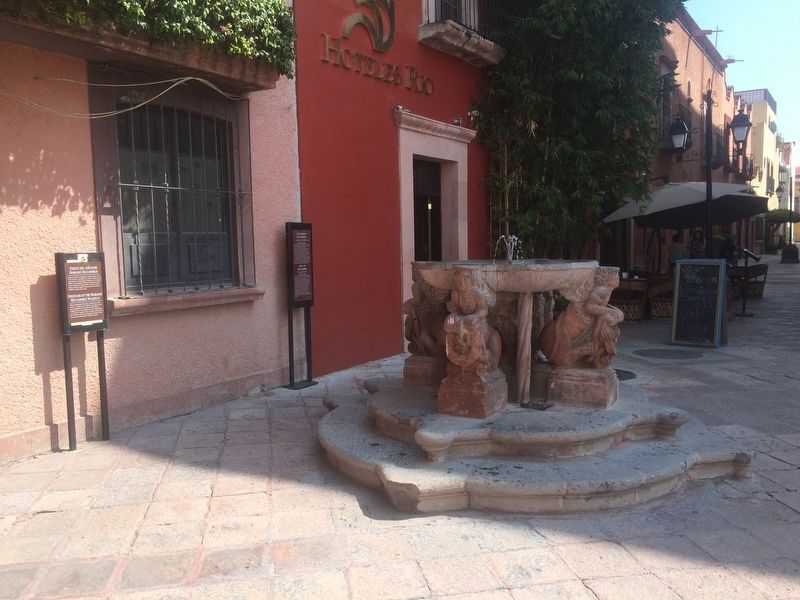
Photographed By J. Makali Bruton, October 2, 2016
4. The previous Alley of Matamoros Marker
In this view towards the east along Andador Mariano Matamoros, the previous marker was to the right. To the far left was the "Fountain of the Mariano Matamoros Walkway" marker, which was removed in 2018. The fountain is in the center of the photo.
Credits. This page was last revised on August 6, 2018. It was originally submitted on October 4, 2016, by J. Makali Bruton of Accra, Ghana. This page has been viewed 360 times since then and 25 times this year. Photos: 1. submitted on May 10, 2018, by J. Makali Bruton of Accra, Ghana. 2, 3, 4. submitted on October 4, 2016, by J. Makali Bruton of Accra, Ghana. 5. submitted on May 10, 2018, by J. Makali Bruton of Accra, Ghana. 6, 7. submitted on October 4, 2016, by J. Makali Bruton of Accra, Ghana.
